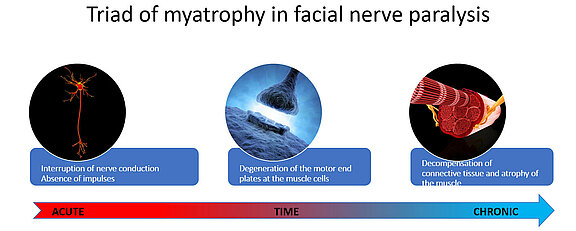In medicine, the term “acute” is used to describe a sudden event. The term “chronic” is used when a disease develops slowly and then lasts for a long time. Acute generally refers to a time span of less than a year, while chronic generally refers to a time period of greater than 18 months. The exact transition between the two terms is somewhat arbitrary and can vary from person to person. The point "Timing" ("Time is muscle") under the tab "Treatment" deals with this process in particular.
Acute facial nerve palsy usually recovers quickly (more precisely under "Causes" and "Prognosis") and can be treated conservatively during this time (see "Conservative treatment").
Complete irreversibility can be said to have occurred after about 18 months, after the onset of paralysis, without any signs of improvement. At this point, the muscles for facial expression are no longer considered to be targets for "reanimation", as they degenerate into fatty tissue in the absence of nerve input.
